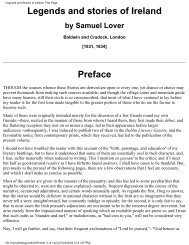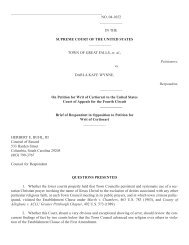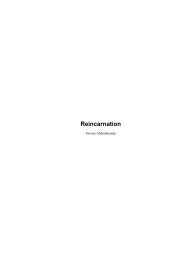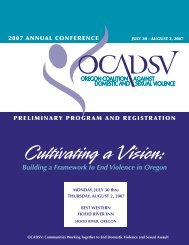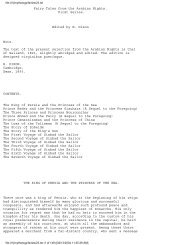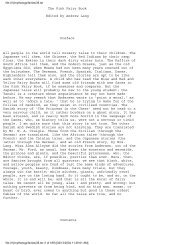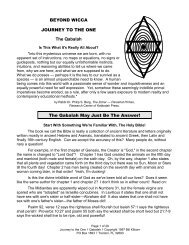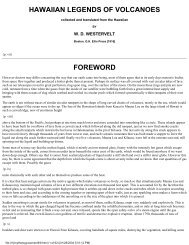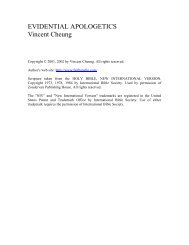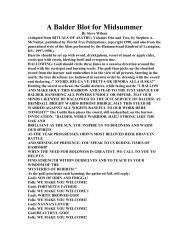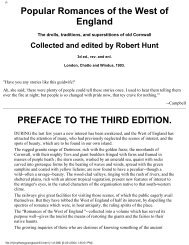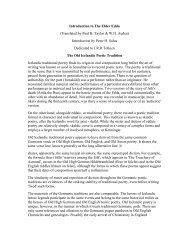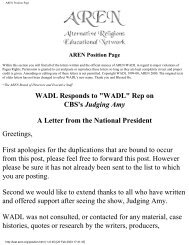Tales and Traditions of the Eskimo - Alternative Religions ...
Tales and Traditions of the Eskimo - Alternative Religions ...
Tales and Traditions of the Eskimo - Alternative Religions ...
Create successful ePaper yourself
Turn your PDF publications into a flip-book with our unique Google optimized e-Paper software.
<strong>Tales</strong> <strong>and</strong> <strong>Traditions</strong> <strong>of</strong> <strong>the</strong> <strong>Eskimo</strong> - Title Page<br />
besides <strong>the</strong> moon <strong>and</strong> several stars. Though it has been asserted <strong>the</strong> Greenl<strong>and</strong>ers believe that <strong>the</strong> first <strong>of</strong><br />
our race arose from <strong>the</strong> earth, <strong>and</strong> that <strong>the</strong> first man, called Kallak, created <strong>the</strong> first woman out <strong>of</strong> a tuft <strong>of</strong><br />
sod, <strong>and</strong> also that some tradition exists about <strong>the</strong> Deluge, yet <strong>the</strong>se statements cannot be accepted without<br />
doubt <strong>and</strong> reservation, because <strong>the</strong>y may have partly originated from <strong>the</strong> questioners <strong>the</strong>mselves, who<br />
pretend to have heard <strong>the</strong>m from <strong>the</strong> Greenl<strong>and</strong>ers, but have probably involuntarily acted upon <strong>the</strong> latter<br />
by p. 39 <strong>the</strong>ir prepossessed mode <strong>of</strong> questioning. Still, on looking at <strong>the</strong> whole religious views <strong>of</strong> <strong>the</strong><br />
natives, <strong>the</strong>y do seem to presuppose a single power by which <strong>the</strong> world is ruled. Certain means were<br />
believed to exist by which man was not only enabled to enter into communion with <strong>the</strong> invisible rulers,<br />
but could also make <strong>the</strong>m his helpers <strong>and</strong> servants. Such supernatural assistance might be acquired in a<br />
more or less direct wayviz., ei<strong>the</strong>r through men endowed with <strong>the</strong> peculiar gift called angakoonek (cor.<br />
spelling angákûne8, signifying angakok-wisdom or -power, or <strong>the</strong> state <strong>of</strong> being angakok). But <strong>the</strong>se<br />
men only acquired this gift by applying to <strong>and</strong> calling on a yet more exalted power, which made <strong>the</strong>se<br />
rulers become <strong>the</strong>ir helping or guardian spirits, or tornat (plural <strong>of</strong> tôrna8). This supreme ruler was<br />
termed tornarsuk; <strong>and</strong> in his being thus enabled to dispose at will <strong>of</strong> all <strong>the</strong> minor powers, forcing <strong>the</strong>m<br />
to serve <strong>the</strong> angakut, <strong>and</strong> in <strong>the</strong> same degree making <strong>the</strong> whole nature subordinate to mankind, some idea<br />
surely <strong>of</strong> <strong>the</strong> godhead must be connected with him. It also seems to have been ascertained that <strong>the</strong><br />
Greenl<strong>and</strong>ers have imagined him as having his abode in company with <strong>the</strong> happy deceased in <strong>the</strong> under<br />
world; but to this vague belief <strong>the</strong> whole doctrine concerning his existence seems to have been limited.<br />
The early authors on Greenl<strong>and</strong>, indeed, have given utterance to different opinions concerning tornarsuk<br />
which <strong>the</strong>y have ga<strong>the</strong>red from <strong>the</strong> natives, some <strong>of</strong> <strong>the</strong>m representing him as <strong>the</strong> size <strong>of</strong> a finger, o<strong>the</strong>rs<br />
<strong>of</strong> a bear, <strong>and</strong> so on; but all <strong>the</strong>se statements seem to rest upon error <strong>and</strong> superficial inquiry. As far as <strong>the</strong><br />
traditions are concerned, <strong>the</strong> name <strong>of</strong> tornarsuk is very rarely mentioned in any <strong>of</strong> <strong>the</strong>m.<br />
Among <strong>the</strong> supernatural powers was ano<strong>the</strong>r constituting <strong>the</strong> source <strong>of</strong> nourishment, supplying <strong>the</strong><br />
physical wants <strong>of</strong> mankind. These being almost exclusively got from <strong>the</strong> sea, we cannot wonder that this<br />
power had its abode in <strong>the</strong> depths <strong>of</strong> <strong>the</strong> ocean; <strong>and</strong> its being represented p. 40 as a female is probably<br />
emblematical <strong>of</strong> <strong>the</strong> continual regeneration <strong>of</strong> life in nature, as well as <strong>of</strong> economy <strong>and</strong> household<br />
management, generally devolving on women. This being is named arnarkuagsak (cor. sp. arnar8uagssâ<br />
8, also signifying old woman in general); but <strong>the</strong> common opinion among <strong>the</strong> older authors, describing<br />
her as a demon <strong>of</strong> evil, is quite erroneous. She sits in her dwelling in front <strong>of</strong> a lamp, beneath which is<br />
placed a vessel receiving <strong>the</strong> oil that keeps flowing down from <strong>the</strong> lamp. From this vessel, or from <strong>the</strong><br />
dark interior <strong>of</strong> her house, she sends out all <strong>the</strong> animals which serve for food; but in certain cases she<br />
withholds <strong>the</strong> supply, thus causing want <strong>and</strong> famine. Her retaining <strong>the</strong>m was ascribed to a kind <strong>of</strong> filthy<br />
<strong>and</strong> noxious parasites (agdlerutit, which also signifies abortions or dead-born children), which had<br />
fastened <strong>the</strong>mselves around her head; <strong>and</strong> it was <strong>the</strong> task <strong>of</strong> <strong>the</strong> angakok to deliver her from <strong>the</strong>se, <strong>and</strong> to<br />
induce her again to send out <strong>the</strong> animals for <strong>the</strong> benefit <strong>of</strong> man. In going to her he first had to pass <strong>the</strong><br />
arsissut, <strong>and</strong> <strong>the</strong>n to cross an abyss, in which, according to <strong>the</strong> earliest authors, a wheel was constantly<br />
turning round as slippery as ice; <strong>and</strong> <strong>the</strong>n having safely got past a boiling kettle with seals in it, he<br />
arrived at <strong>the</strong> house, in front <strong>of</strong> which a watch was kept by terrible animals, sometimes described as<br />
seals, sometimes as dogs; <strong>and</strong> lastly, within <strong>the</strong> house-passage itself he had to cross an abyss by means <strong>of</strong><br />
a bridge as narrow as a knife's edge.<br />
According to <strong>the</strong> religious notions just given, <strong>the</strong>re must have existed a generally established belief in <strong>the</strong><br />
presence <strong>of</strong> some ruling power to which mankind <strong>and</strong> nature were alike subjected, as well as in certain<br />
modes <strong>of</strong> obtaining assistance from this power. This supernatural aid, as well as all <strong>the</strong> actions <strong>of</strong> men<br />
with a view to call it forth, were in social estimation considered as being good <strong>and</strong> proper. But besides<br />
file:///I|/mythology/american indian/24/24.html (30 <strong>of</strong> 317) [01/24/2004 8:57:48 AM]



